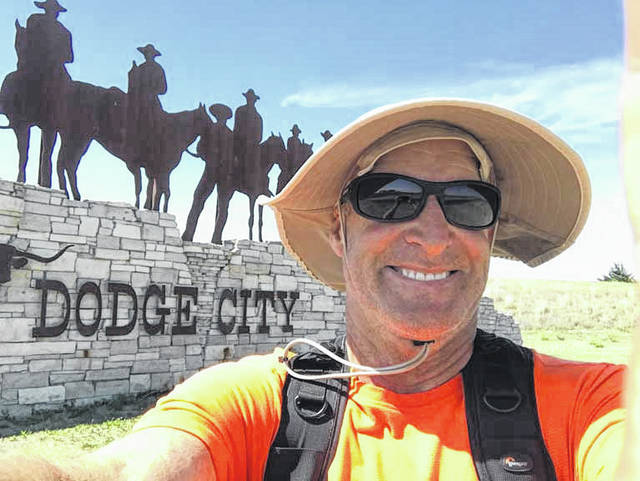
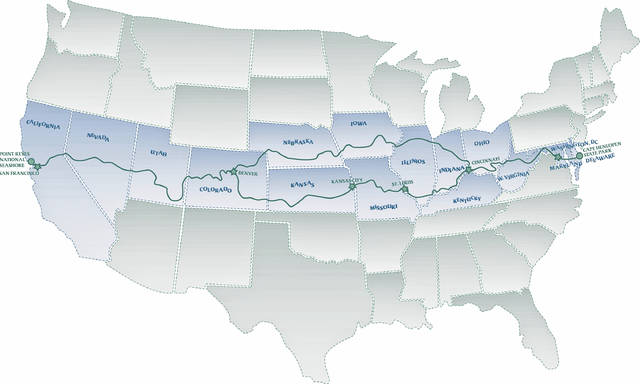
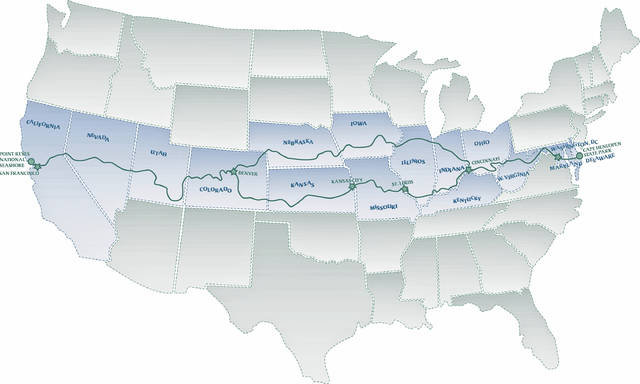
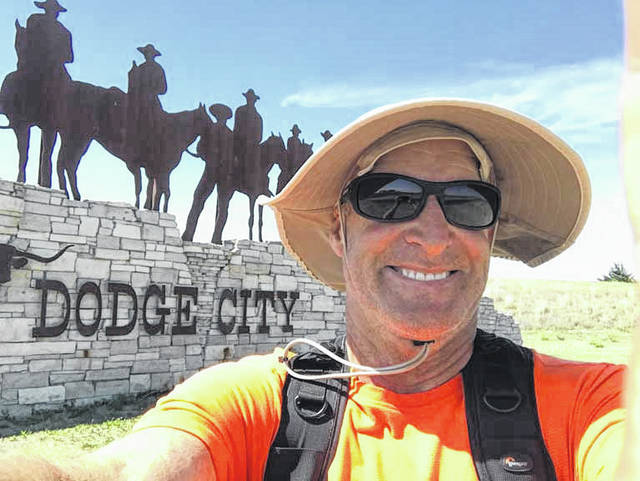
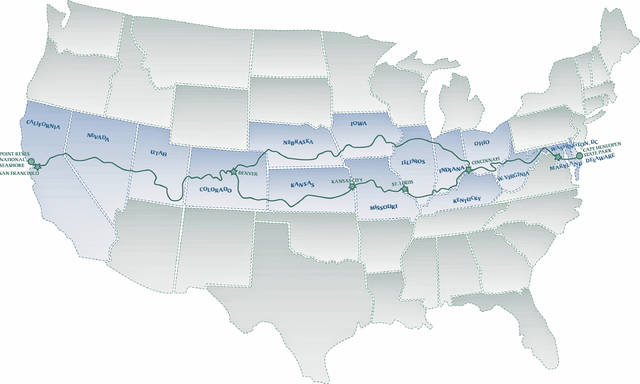
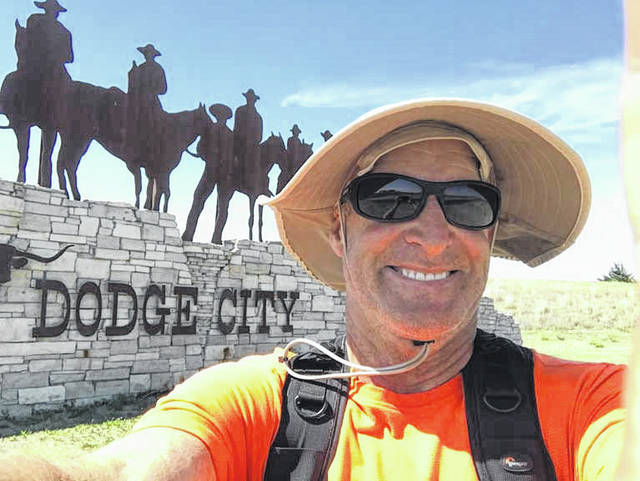
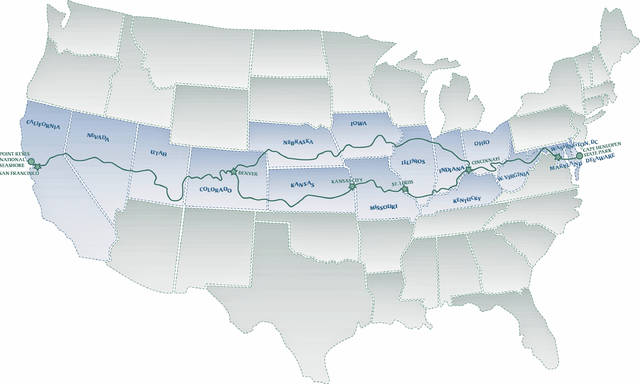
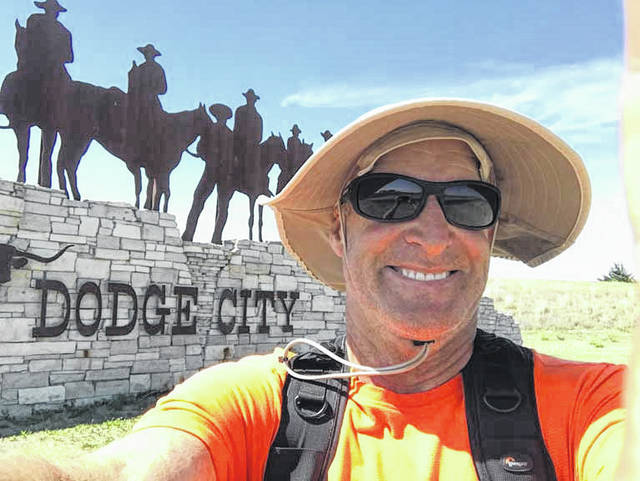
ST. SIMONS ISLAND, Ga. — The American Discovery Trail may be the country’s best kept secret.
If so, a Shelby County native is in on it. Roger Ditmer, who grew up near Hardin and now lives in St. Simons Island, Georgia, is in the second year of a three-year plan to walk the length of the trail that stretches from Lewes, Delaware, to Point Reyes National Seashore, California.
The sea-to-shining-sea path totals 6,800 miles and passes through 15 states. It utilizes national, state and local trail systems and for the most part avoids cities, taking hikers and bicyclists through rural and small town America.
“I got the idea (for a cross-country hike) about 10 years ago. God called me out on something,” Ditmer said. While on the Internet in 2008, he came across information about the American Discovery Trail. A horticulturist by trade, he semi-retired in December 2016 and started his trek last summer.
“My plan was to walk roughly a third of the trail in 2017, another third in 2018 with completion in 2019. Walking an average of 25 miles per day, six days a week, I anticipate roughly a total of nine months on the trail over the three-year period,” he said.
During 2017, Ditmer covered 1,668 miles, from Delaware to St. Louis.
This year, he started at St. Louis and had made it as far as Cripple Creek, Colorado, when he talked with the Sidney Daily News, Wednesday, June 13, from Georgia. He had returned home for a week to work on horticulture contracts and will go back to Denver, Sunday, to pick up the trail. He hopes to make it to the border between Colorado and Utah before the snow flies.
“I don’t know why the American Discovery Trail is not known,” Ditmer said.
Carole Tomhave, administrator of the volunteer organization that oversees the trail, has a theory about that.
“It’s not its own trail,” she said. “It’s a network of existing rail trails, greenways and national park trails.” About 20 years old, the route was a joint project of Backpackers magazine and the American Hikers Association to link trails from coast to coast.
When trails couldn’t be linked, “they would find the least-traveled road — gravel or dirt roads — to get from trail to trail,” Tomhave said.
Although the trail as a whole may not be famous, “each of the component parts is well known by the residents where they are,” she said. “Much of it is bike-able. A lot of people doing the whole thing will do a mix of bicycling and hiking.”
Tomhave estimates that 10 to 15 people complete the whole trail in any given year, although they may not have traversed the it all at once.
“Most people hike near where they live,” she said.
Ditmer’s path this year had him walking for awhile in the footsteps of the Lewis and Clark expedition of 1804. Meriwether Lewis and William Clark set out from St. Louis with a company of soldiers and were the first explorers to travel through the western territories that would become the United States.
“As I left the Missouri River, I picked up the Santa Fe Trail in Kansas. I paralleled it for miles. All the history is mind-boggling,” Ditmer said. He has been particularly interested in the Native American history the Discovery trail has allowed him to discover. He’s also learning Civil War history as he walks. He’s listening to Civil War audiobooks by Shelby Foote and Ken Burns.
The adventure of the trail is a new one for Ditmer.
“Being a farm boy, I stayed in shape. But I never walked. I never even backpacked. I went from a few thousand steps (tracked on his watch) to 60,000 steps,” he said. Traveling with just two changes of clothes and camping gear, which he pulls in a rolling pack harnessed to his shoulders, Ditmer begins to look for a stream or lake at about 2 p.m. each day.
“I go into the water, clothes and all,” he said. That’s one way to get his clothes and his body clean. He then hikes for another two hours, during which he and his clothes dry out. He switches out his shoes every 700 miles. The tent is pitched 85 percent of the time. When he can, every 10 days or so, he’ll book a hotel room to enjoy a hot shower and a good bed. Sometimes, he is invited to be a guest of people who live along trail.
He carries instant mashed potatoes and canned chicken for the times he can’t find a restaurant for a meal. But, he noted, even villages that are almost ghost towns will have cafes. He uses a filter to process drinking water.
The biggest danger this year, through the plains states, has been rattlesnakes. They curl up in abandoned gopher holes along the shoulders of the roadway.
“I’m tending to stay back from the edges of the roads,” Ditmer said. “They’ll poke their heads out and look at you as you pass.” As he starts the next section of trail, he’ll begin to hang his food bag. In the mountains, he’ll be on the lookout for pumas and bears. The hiker said he is not concerned about navigating the Rockies alone.
“This is not my walk. It’s God’s walk,” he said. Although he doesn’t proselytize, he knows that his personal reason for undertaking the coast-to-coast trek is for the glory of God. He makes notes of his experiences and has collected information for sermons. He also shoots 30 to 40 photographs each day.
Having felt called by his faith to undertake this walk, his goal has been to encounter people with two concepts: “Be Thankful” and “Be Encouraged.”
“This often leads into a discussion of faith and the uniqueness of hope through the Christian belief,” he said. His motto is “Live Like You Believe” with Philippians 4:4-8 being the scriptural context most often highlighted: “Rejoice in the Lord alway: and again I say, Rejoice. Let your moderation be known unto all men. The Lord is at hand. Be careful for nothing; but in every thing by prayer and supplication with thanksgiving let your requests be made known unto God. And the peace of God, which passeth all understanding, shall keep your hearts and minds through Christ Jesus. Finally, brethren, whatsoever things are true, whatsoever things are honest, whatsoever things are just, whatsoever things are pure, whatsoever things are lovely, whatsoever things are of good report; if there be any virtue, and if there be any praise, think on these things.”
Ditmer is the son of Barbara Ditmer, of rural Hardin, and the late Marvin Ditmer. Married, with three daughters and two grandchildren, Roger graduated from Houston High School in 1974 and from Ohio State University with a degree in landscape horticulture. He worked in Chicago, the British Virgin Islands and the U.S. Virgin Islands before spending 23 years as the landscape horticulturist at the Cloister at Sea Island, Georgia. Semi-retired, he continues to consult on tree care through his one-man business, Tree Guy LLC.



